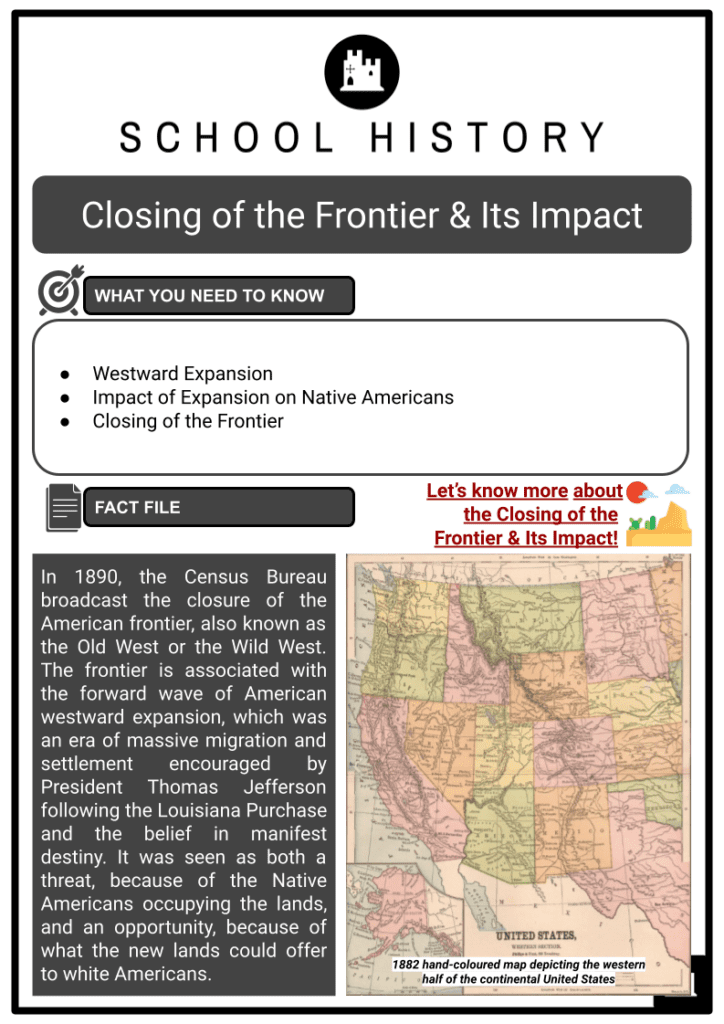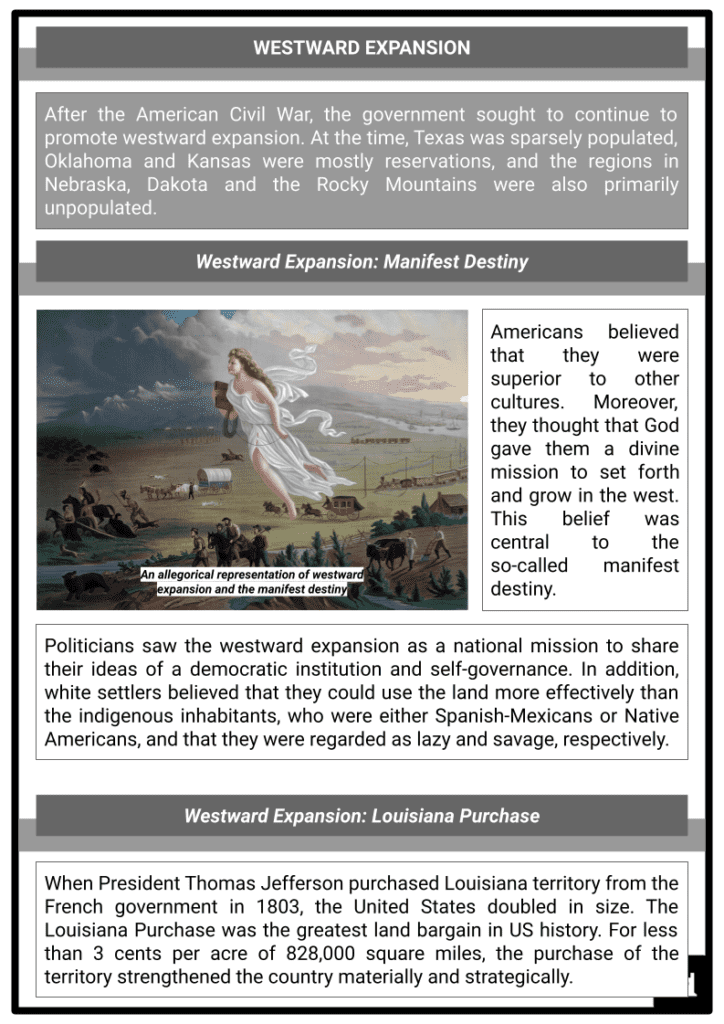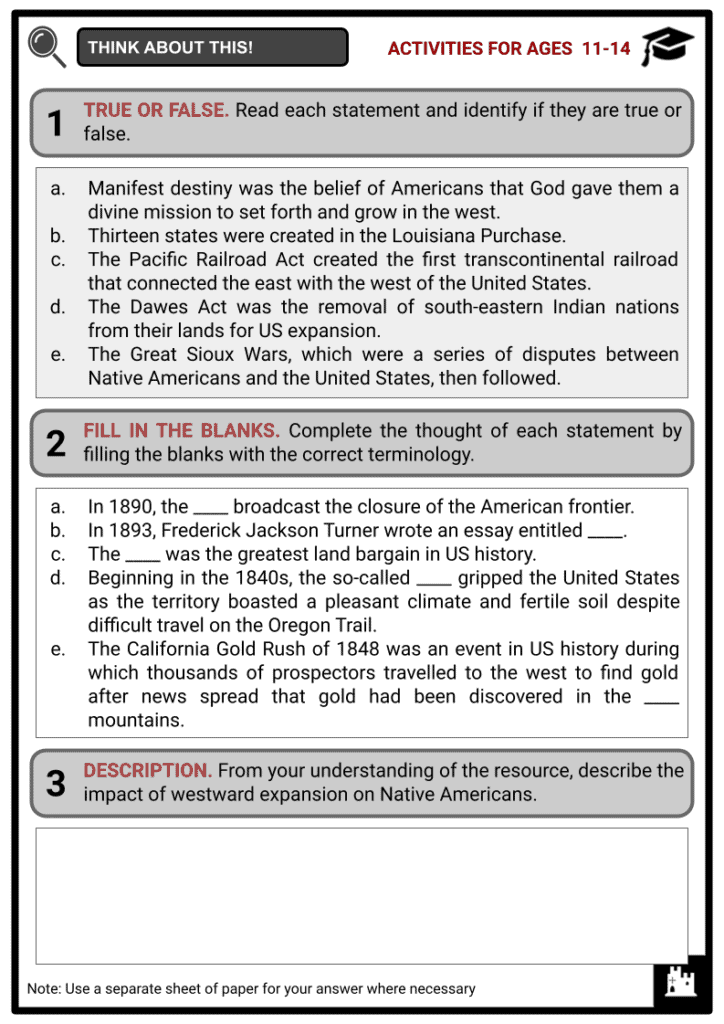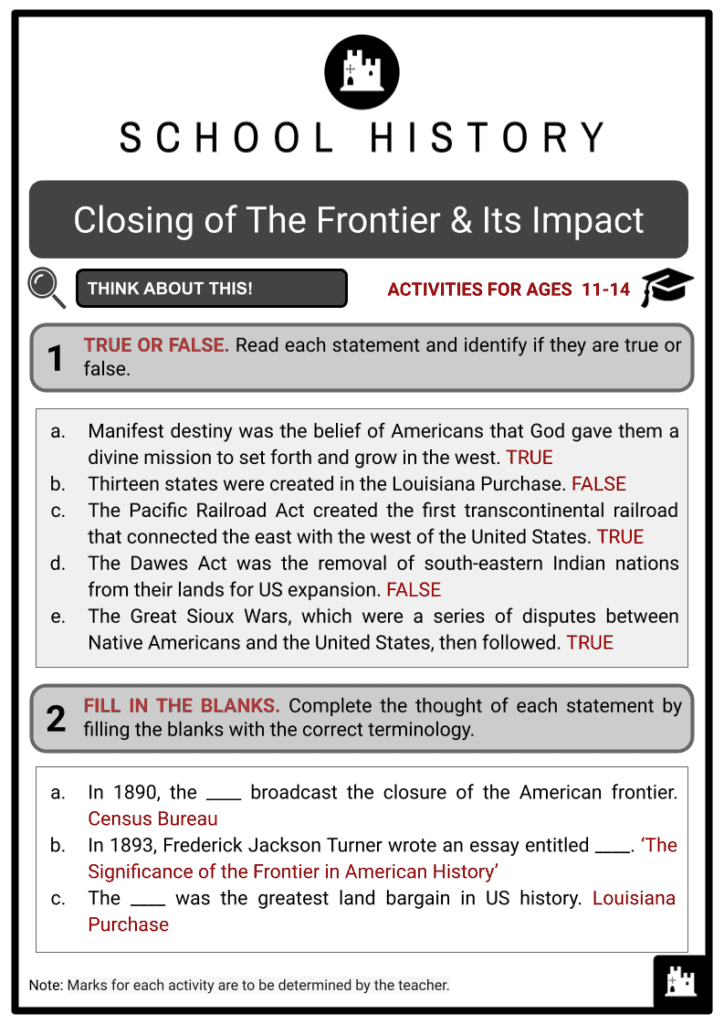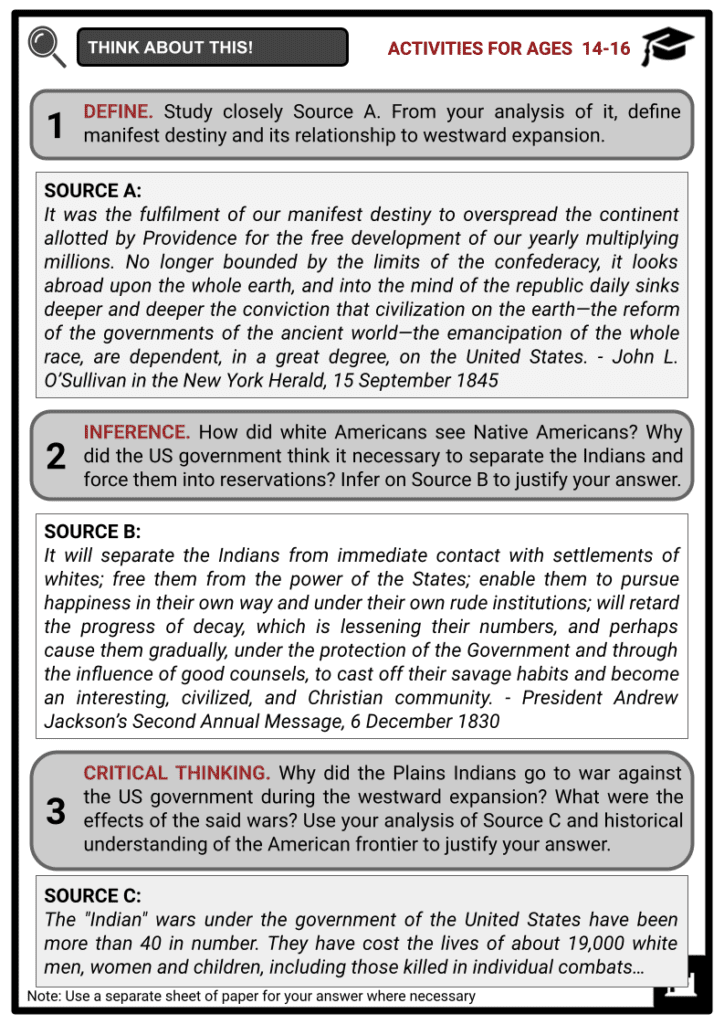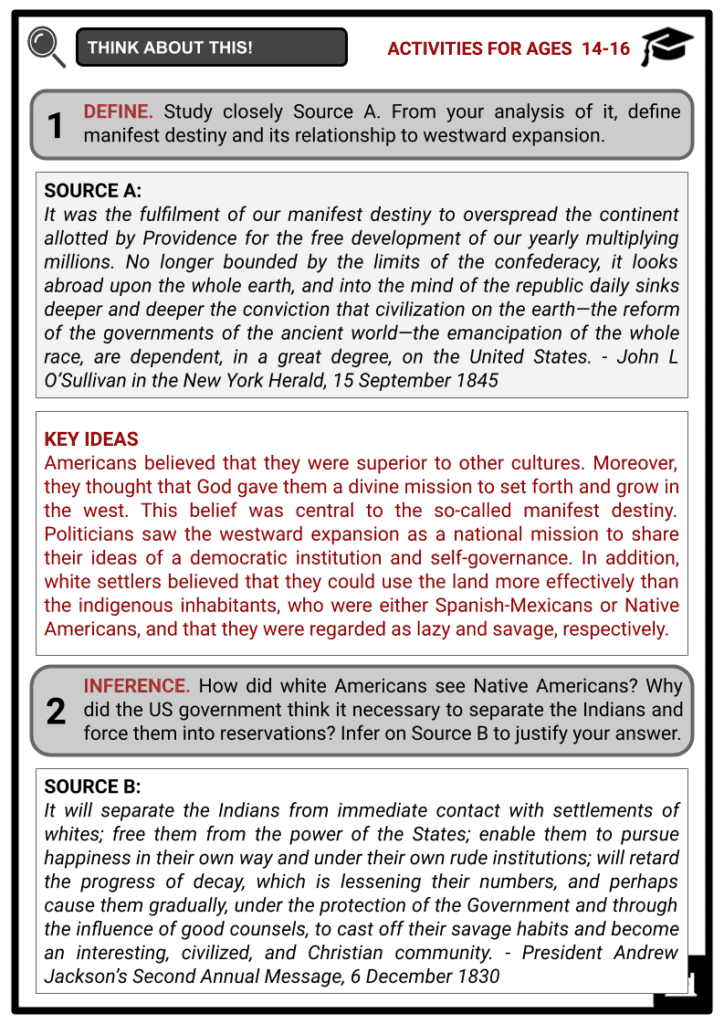Closing of the Frontier & Its Impact Worksheets
Do you want to save dozens of hours in time? Get your evenings and weekends back? Be able to teach about the Closing of the Frontier & Its Impact to your students?
Our worksheet bundle includes a fact file and printable worksheets and student activities. Perfect for both the classroom and homeschooling!
Summary
- Westward Expansion
- Impact of Expansion on Native Americans
- Closing of the Frontier
Key Facts And Information
Let’s find out more about the Closing of the Frontier & Its Impact!
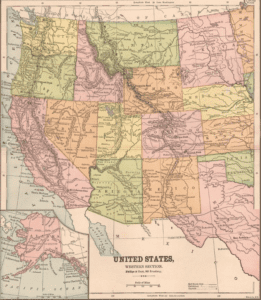
In 1890, the Census Bureau broadcast the closure of the American frontier, also known as the Old West or the Wild West. The frontier is associated with the forward wave of American westward expansion, which was an era of massive migration and settlement encouraged by President Thomas Jefferson following the Louisiana Purchase and the belief in manifest destiny. It was seen as both a threat, because of the Native Americans occupying the lands, and an opportunity, because of what the new lands could offer to white Americans.
WESTWARD EXPANSION
After the American Civil War, the government sought to continue to promote westward expansion. At the time, Texas was sparsely populated, Oklahoma and Kansas were mostly reservations, and the regions in Nebraska, Dakota and the Rocky Mountains were also primarily unpopulated.
Westward Expansion: Manifest Destiny
- Americans believed that they were superior to other cultures. Moreover, they thought that God gave them a divine mission to set forth and grow in the west. This belief was central to the so-called manifest destiny.
- Politicians saw the westward expansion as a national mission to share their ideas of a democratic institution and self-governance. In addition, white settlers believed that they could use the land more effectively than the indigenous inhabitants, who were either Spanish-Mexicans or Native Americans, and that they were regarded as lazy and savage, respectively.
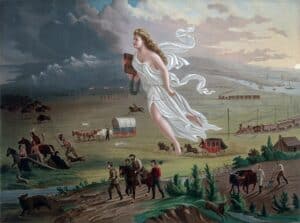
An allegorical representation of westward expansion and the manifest destiny
Westward Expansion: Louisiana Purchase
- When President Thomas Jefferson purchased Louisiana territory from the French government in 1803, the United States doubled in size. The Louisiana Purchase was the greatest land bargain in US history. For less than 3 cents per acre of 828,000 square miles, the purchase of the territory strengthened the country materially and strategically.
- Fourteen states (namely Arkansas, Colorado, Iowa, Kansas, Minnesota, Missouri, Montana, Nebraska, New Mexico, North Dakota, Oklahoma, South Dakota, Texas and Wyoming) were created from that one land deal, earning Thomas Jefferson one of his most important achievements during his presidency.
Westward Expansion: Oregon Trail
- Beginning in the 1840s, the so-called Oregon Fever gripped the United States as the territory boasted a pleasant climate and fertile soil despite difficult travel on the Oregon Trail.
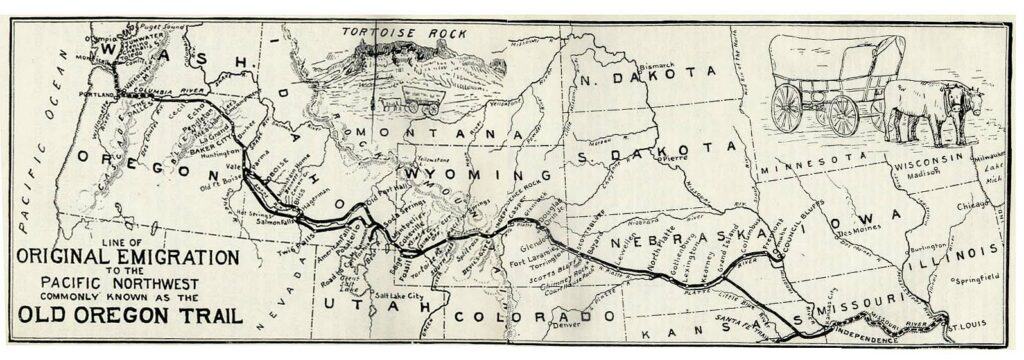
Modern map of the US showing the Louisiana Purchase in white - In 1825, the route through the Rocky Mountains became known as the Oregon Trail. Going to Oregon and California was easier when people used this route through the Rocky Mountains. Missionaries were the first people to use this route using wagons in 1836. In 1840, the Walker family was the first family to make the trip. Three years later, around 900 people used the trail. This was known as the Great Emigration.
- As part of its expansion efforts, the US government encouraged people to migrate to Oregon to make it an official part of US territory. By 1846, more than 5,000 people had moved westwards and used the Oregon Trail.
- In 1841, the US government allotted $30,000 to map the Oregon Trail to serve as a guide for settlers. The length of the entire Oregon Trail was 3,200km. It was used by white settlers migrating to the West. Those heading to California using the trail would travel a total of 3,800km. Travelling westwards using the Oregon Trail was difficult and migrants encountered a number of problems during the trip.
Westward Expansion: Gold Miners
- The California Gold Rush of 1848 was an event in US history during which thousands of prospectors travelled to the west to find gold after news spread that gold had been discovered in the Sierra Nevada mountains.
- In San Francisco, the story was met with indifference until Sam Brannan started showing off a vial of gold that he had obtained from Sutter’s Creek, which caused an influx of miners into the region. At first, only those who could travel by boat came to California, from Oregon, present-day Hawaii, Mexico, Chile, Peru and even China.
- Over time, San Francisco’s economy blossomed and was the central metropolis of the new frontier. To support the needs of the miners, towns with shops, bars, brothels, saloons and other businesses seeking to make a fortune from the rush sprang up in the region.
- Later, in his inaugural address, President James Polk announced the abundance of gold in California, causing another influx of prospecting settlers from the east of America. The earliest gold-seekers collected large amounts of gold in the year 1848. However, the following year, when the news of gold spread throughout the world, an overwhelming number of prospective miners from around the world flooded to California. They were referred to as forty-niners.
- There was overcrowding and rampant lawlessness, with an increase in banditry, gambling, prostitution and violence. The non-native population grew from an estimated 800 in March 1848 to 20,000 at the end of the year and 100,000 in 1849.
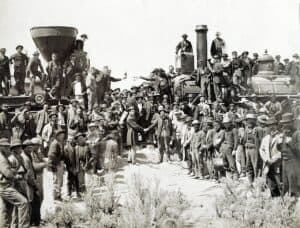
The transcontinental railroad
Westward Expansion: Transcontinental Railroad
- As the Civil War divided the nation, Lincoln introduced the Pacific Railroad Act in 1862 to offer some hope to Republican supporters. It promised a chance for land in the west and a railway to make settlement possible.
- The Pacific Railroad Act created the first transcontinental railroad that connected the east with the west of the United States. Two companies were tasked with the project – the Central Pacific (east) and the Union Pacific (west).
- The Central Pacific railroad would begin in Sacramento in the east, while the Union Pacific railroad was from Omaha in the west. The two would meet in the middle to form the transcontinental railroad. The US government loaned each company $16,000 per mile of track ($48,000 for areas that were mountainous).
- Plains Indians’ rights to the land were stripped to enable construction. Some of the problems included 12,000 deaths while building the railway, and companies almost going bankrupt. This saw them lie in order to receive more loans and funds.
Westward Expansion: Homestead Act
- President Lincoln’s Homestead Act in 1862 was the other tool for promoting westwards settlement. People, including free slaves, were given land for a meagre sum, provided they settled and developed the property for five years, after which their title was confirmed.
- The act was passed, allowing families to claim 162 acres of farm land for five years, after which they could claim it as their own. In response, thousands of European immigrants and freedmen claimed land in the west. They were called homesteaders. As they settled the Plains, many encountered problems with ranch owners and Native Americans.
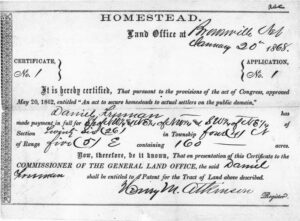
Certificate of homestead in Nebraska - Based on the law passed, the process was this: an individual would file an application, then they would improve the land, and file for the patent. However, Native Americans lost much of their land because of this law.
- The Homestead Act was successful in terms of the number of people who claimed land, migrated and permanently settled on the Great Plains. By 1876, more than six million acres of land had been claimed.
- Despite its success, the act had its pitfalls. For example, even if more land was claimed, 60% of the homesteads did not meet the conditions set out by the act due to poor farming conditions on the Plains. In addition, some landowners veered away from the aims of the act. They either sold their claims to others for profit or filed claims and were forced to turn their land over to rich landowners, which was clearly a violation of the Homestead Act.
Westward Expansion: Cattle Ranching
- When Jefferson purchased the Louisiana territory from France, hundreds of settlers started to migrate westwards in the hope of boosting their profits from the fertile land that the west had to offer. In addition, the expanse of land would provide more work opportunities in the field of agriculture, mining and railway building.
- As the railways were built, large herds of cattle were driven by cattlemen and cowboys to the railways. These would then be sold to the Indians in the east, which led to the construction of cow towns along the railway.
- Cattle raised on the Great Plains were fatter and could survive longer in various weather conditions. Rather than driving cattlers, ranching cattles started on the Plains. This changed the way cowboys worked in the field.
- By 1900, 14 new states had emerged from the western territories, with Colorado being admitted into the Union in 1876, a hundred years after the US acquired the status of nationhood, and was called the Centennial State. North Dakota, South Dakota, Montana, Washington, Idaho and Wyoming were admitted between the years 1889 to 1890 following the northwest ordinances that provided the criteria for the recognition of states. Utah was admitted in 1896 once the Mormons in the region, who were initially led by Brigham Young, renounced polygamy.
- In 1889, lands in Oklahoma that were reserved for the Creeks and the Seminoles were opened for settlement and 50,000 ‘boomers’ and ‘89ers’ acquired land in the region, enabling its admission into the Union in 1907.
IMPACT ON NATIVE AMERICANS
- The Indian-Removal Act of 1830 saw the removal of south-eastern Indian nations from their lands for US expansion. Some removal operations were forced, and thousands died in the process.
- The act also created the establishment of a permanent Indian frontier, which was a boundary between the US and Indian territory. The Indians’ territory shrank as a result of this.
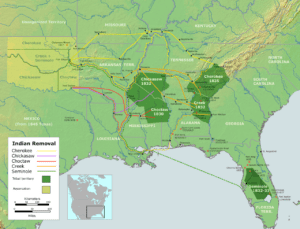
Map showing the routes of Indian removal - Before the colonies and the United States were established, the North American territory was inhabited by the Indian nations. They were considered to be sovereign nations but, later on, were seen as ‘barriers’ to US expansion. Through peace treaties, the Native Americans surrendered some of their land. In 1824, the US War Department created the Bureau of Indian Affairs and tasked them with establishing a partnership between the Native Americans and the new white settlers.
- In order to avoid further tension between the Native Americans and white settlers, Presidents Jefferson and Monroe both proposed the idea of separate homelands for the natives. By 1830, President Jackson believed that the natives were not entitled to own land and he signed the Indian-Removal Act, which gave over land west of the Mississippi River in exchange for their holdings in the east.
- As a result of about 70 removal treaties, over 46,000 eastern Native Americans moved west. Some nations, including the Cherokee and Seminole, were removed by force. Among the tragic experiences was the Cherokees Trail of Tears from Georgia to the new Indian territory, a journey that saw the death of thousands of individuals.
- The Trail of Tears was the forced relocation of south-eastern Native Americans, specifically the Cherokee nation, to Indian territory west of the Mississippi River. Thousands died as they suffered from exposure, starvation and disease during the journey to the west. Though the term ‘Trail of Tears’ is commonly used to refer to the forced removal of the Cherokee nation, it also invokes the collective suffering of the Native Americans who were forced from their home.
- The attitude of the early government towards the natives was expressed through policies developed by the government. Policies are an embodiment of government intentions. They are either distributive or redistributive, like tax laws, or regulations which compel a particular behaviour from citizens. If they are to be effective, the government and its agencies must identify the problem correctly.
- The term ‘policies’ includes a wide range of government actions, from laws by the state and federal government to administrative decisions outlined by the executive arms of government at the state and federal government level. The judiciary is responsible for interpreting laws, especially the bill of rights, and therefore judicial decisions shape policy development or implementation.
- What followed next was a timeline of policies, including judicial decisions about the Plains Indians, the intentions behind them, an overview of the provisions outlined in the specific policies, and their outcomes.
- The Great Sioux Wars, a series of disputes between Native Americans and the United States government, then followed. Collectively, they are considered the largest and greatest US Army–Indian war in American history. It lasted 18 months from March 1876 to September 1877. Its most iconic battle was the Battle of Little Bighorn.
- From 1887 to 1933, the US continued pursuing policies for the assimilation of Native Americans into the broader American society. The law provided for Indian reservation land to be allocated to individual Native Americans and suspended their right to sell for 25 years, but reservation land that was left after the allotment process could be sold to an outsider.
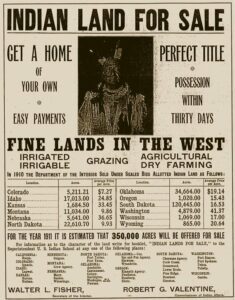
An ad offering Indian land for sale - In 1887, US President Grover Cleveland signed into law the Dawes Act, which authorised the federal government to divide the land of the Plains Indians. Assimilation with white American culture and society was the ultimate aim of the law. Efforts were made for the Native Americans to abandon their traditions. The Plains Indians were expelled from their tribal lands. More than 90 million acres of their land was sold to white Americans.
- The act allotted each family of the Plains Indians a 160-acre homestead on their reservation. The rest of the lands would be sold to white Americans. The Plains Indians were forcibly confined to the allotted reservations. Some land was not arable. Only those who accepted the land allotted to them would be allowed to acquire US citizenship.
- In an attempt to ‘civilise’ the Plains Indians (make them live like the white settlers), the US government forced Indian children to attend boarding schools, which would separate them from their parents. Education was one way for the Americans to disseminate their culture.
- Children were forced to abandon their rituals and traditions. Instead, they were taught how to live as Christians. If they refused, they were punished. They were also not allowed to practise their traditions or to speak their native language.
- The US government denied provisions of food and other supplies to Indian families who refused to send their children to school. Forced to agree, more than 2,000 Indian children were sent to 117 boarding schools in the west.
THE CLOSING OF THE FRONTIER
- In 1890, the Census Bureau broadcast the closure of the American frontier. This news was a distinguished event in American history as the frontier was seen as both a threat and an opportunity. It also had a limitless aspect upon which Americans could extend their institutions and democracy through manifest destiny.
- There was a 25.5% increase in the population, amounting to more than 62 million people residing in the country. The distribution of the country’s population resulted in the frontier’s closure, since the western territories were occupied by white Americans.
- Homesteads, cow towns, ranches, mining zones, and cities were built. By the 1890s, white Americans had successfully fulfilled the belief in manifest destiny by expanding their settlements into the west.
- According to the 1890 US Census Bureau, it was revealed that the population of Plains Indians went down from 400,764 in 1850 to 248,253 (Dippie, 1982). By 1890, the population of the Plains Indians decreased in the west. This was the result of turbulent events involving white settlers, the US government and the Plains Indians.
- The frontier had become a safety valve for the American people and, when tough economic times hit the southern and northern regions, people occupied the frontier to start over. The Indian frontier’s closure served as an opportunity for Frederick Jackson Turner, an American historian, to reflect on the significance of the frontier region to the lives of white Americans and their expansion of settlements to the west.
- In 1893, Turner wrote an essay entitled ‘The Significance of the Frontier in American History’, in which he argued that the frontier brought out the best in Americans and developed values of self-reliance and individualism ‘unique’ to American society.
- Critics accused Turner of promoting a revisionist view of what had happened in the west. He failed to take into account that the westward expansion was a result of abusive policies on the part of the US government towards the Plains Indians.
- The tribes suffered a significant blow because of the policies of the US government. Half a century later, Native Indian land had decreased from 154 million acres in 1887 to 48 million in 1934. In 1928, the Meriam report documented the poverty and suffering of the Native Americans due to the policies.
- The report, while supporting that government policy continued in its objective of assimilating the Native Americans, spoke against ‘the disastrous attempt to force individual Indians or groups of Indians to be what they do not want to be, to break their pride in themselves and their Indian race, or to deprive them of their Indian culture’.
Image Sources
- https://upload.wikimedia.org/wikipedia/commons/d/df/Western_United_States_1882.png
- https://upload.wikimedia.org/wikipedia/commons/thumb/f/fd/American_Progress_%28John_Gast_painting%29.jpg/1280px-American_Progress_%28John_Gast_painting%29.jpg
- https://upload.wikimedia.org/wikipedia/commons/1/19/Oregontrail_1907.jpg
- https://upload.wikimedia.org/wikipedia/commons/thumb/a/aa/East_west_shaking_hands_by_russell.jpg/1280px-East_west_shaking_hands_by_russell.jpg
- https://upload.wikimedia.org/wikipedia/commons/4/4f/Freeman_homestead-certificate.jpg
- https://upload.wikimedia.org/wikipedia/commons/thumb/1/16/Trails_of_Tears_en.png/1280px-Trails_of_Tears_en.png
- https://upload.wikimedia.org/wikipedia/commons/b/bf/Indian_Land_for_Sale.jpg

